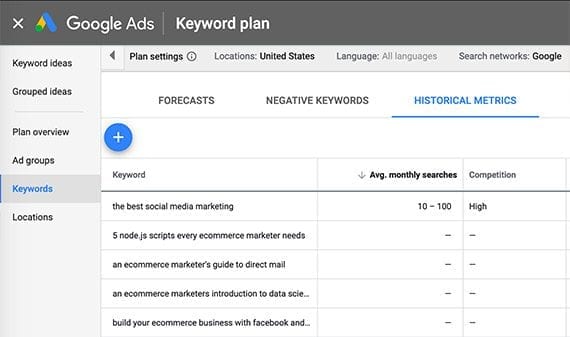I have to come up with lots of article ideas. I have a few methods, including reading industry-specific content and following links they reference. This morning, I was sitting in my office, sipping Topo-Chico mineral water and reading through my Feedly list for the day.
One article led to another, and I ended up on a three-year-old Sumo post titled “How Nat Eliason Grew A Website To 10K Visitors In A Month.” I don’t know Eliason, but I was impressed.
Eliason is the founder of a content marketing agency, the host of a podcast called “Made You Think,” and the owner of Cup & Leaf, an online tea retailer. In the article, he stated that his visitors came from organic search. He described his method of developing article topics, which included keyword research techniques and brainstorming to create a list on a spreadsheet.
The process didn’t seem revolutionary. But it apparently helped Eliason generate a lot of site traffic for Cup & Leaf.
I decided to test it. If I could come up with titles for 10 ecommerce marketing articles that you want to read, you might use Eliason’s approach and generate some topics for your own content marketing efforts.
Article List
With my topic in mind — ecommerce marketing — I created an initial list of article ideas and organized them in a spreadsheet.
In his example, Eliason started with types of tea, where tea is grown, things you add to tea, and types of teapots.
| Types of Tea | Tea Locales | Mixers | Tea Pot Types |
|---|---|---|---|
| Black | China | Honey | Yixing |
| Green | India | Sugar | Ceramic |
| Oolong | South America | Milk | Cast Iron |
| Rooibos | Africa | Lemon | Glass |
| Pu-erh | Japan | Porcelain | |
| Mate | The Middle East | ||
| Guayusa | |||
| White |
It took me a while to settle on keywords for ecommerce “marketing tactics” and “marketing skills.” Here they are.
| Marketing Tactics | Marketing Skills |
|---|---|
| Content Marketing | App Development |
| Contest Marketing | Audio Editing |
| Coupon Marketing | Backend Development |
| Direct Mail Marketing | CMS Mastery |
| Email Marketing | Copywriting |
| Facebook Ads | Customer Psychology |
| Google Ads | Data Science |
| Influencer Marketing | Editing |
| Link Building | Front-end Development |
| List Building | Google Ads |
| Mobile Marketing | Google Analytics |
| On-site Merchandising | Graphic Design |
| Pay-per-click Advertising | Marketing Automation |
| Podcasting | Photography |
| Radio Advertising | Social Media Mastery |
| Reddit Ads | Statistics |
| Retargeting | UX Design |
| Search Engine Optimization | Video Editing |
| Video Advertising | |
| Voice Search | |
| YouTube Ads |
Add generators. Next, I added a third column of what Eliason called “generators.” These are phrases that could be added to the front or back of the words in my Tactics and Skills columns.
The generators reminded me a bit of BuzzFeed, which is known for its attention-grabbing, but, perhaps, formulaic headlines.
To help come up with a list of potential generators, I used Ahrefs’ Content Explorer. I typed in “content marketing” and then took the beginnings and endings of several top-performing articles. Although these generators are not prefixes and suffixes, I labeled them that way to help me remember their order.
| Marketing Tactics | Marketing Skills | Generators: Prefix | Generators: Suffix |
|---|---|---|---|
| Content Marketing | App Development | How to Grow Your Business with | Best Practices |
| Contest Marketing | Audio Editing | The Best | Is the Next Big Thing for Ecommerce Marketing |
| Coupon Marketing | Backend Development | X Tools for | vs. Content Marketing |
| Direct Mail Marketing | CMS Mastery | X Mistakes You Might be Making with Your | |
| Email Marketing | Copywriting | X Stats that will Make You Invest in | |
| Facebook Ads | Customer Psychology | ||
| Google Ads | Data Science | ||
| Influencer Marketing | Editing | ||
| Link Building | Front-end Development | ||
| List Building | Google Ads | ||
| Mobile Marketing | Google Analytics | ||
| On-site Merchandising | Graphic Design | ||
| Pay-per-click Advertising | Marketing Automation | ||
| Podcasting | Photography | ||
| Radio Advertising | Social Media Mastery | ||
| Reddit Ads | Statistics | ||
| Retargeting | UX Design | ||
| Search Engine Optimization | Video Editing | ||
| Video Advertising | |||
| Voice Search | |||
| YouTube Ads |
Concatenate. The words from my lists of tactics and skills are concatenated, meaning combined, with the generators to create a long list of potential topics.
In his article, Eliason used Google Sheets’ concatenate function to do this. Assuming your first generator is in cell C2 and your first root word is in A2, the following Google Sheets’ formula would create a topic.
=CONCATENATE($C$2," ",A2)
The “$” before the “C” and “2” tells Google not to change these when you copy and paste or drag the formula from cell to cell. Using this technique, I quickly had several initial headline topics, including:
- “How to Grow Your Business with Content Marketing,”
- “How to Grow Your Business with Contest Marketing,”
- “How to Grow Your Business with Coupon Marketing,”
- “How to Grow Your Business with Direct Mail Marketing.”
Use a Node.js script. In all, I had 22 marketing tactics and 19 marketing skills for 41 topic roots or keywords. I also identified 10 generators. Thus, I would be concatenating my way to 410 initial topics.
That seemed like a lot of dragging and copying. So rather than using a Google Sheet to generate the topics, I wrote a JavaScript to do the concatenation for me.
My keywords or topic roots were stored as an array of strings. They ellipsis indicates the missing keywords.
let keywords = [
"Content Marketing",
"Contest Marketing",
...
];I did the same thing for my generators, creating an array for my beginnings and endings.
let prefix = [
"How to Grow Your Business With",
"The Best",
...
];
let suffix = [
"Best Practices",
"Is the Next Big Thing for Ecommerce Marketing",
...
];Next, I looped over the various arrays.
keywords.forEach(keyword => {
prefix.forEach(beginning => {
console.log(beginning + " " + keyword);
});
suffix.forEach(ending => {
console.log(keyword + " " + ending);
})
});The entire script took less than three minutes to write. It generated my full list of initial topics. I copied and pasted these into my Google spreadsheet.

This short script could be run from a terminal and is faster than trying to concatenate the keywords and generators in a spreadsheet.
Add meta topics. Next, Eliason encourages readers to add “meta topics” to the list. I had just auto-generated more than 400 possible article titles, and I didn’t want to rule any of them out. They might work for larger, in-depth articles and thus have good search engine potential.
Nonetheless, here are some of the meta topics I thought of.
- “5 Node.js Scripts Every Ecommerce Marketer Needs”
- “Build Your Ecommerce Business with Facebook and Reddit Ads”
- “An Ecommerce Marketer’s Guide to Direct Mail”
- “Predictive Marketing: Understanding the Data That Drives Sales”
- “An Ecommerce Marketer’s Introduction to Data Science”
Organize, Eliminate Topics
Recall that Eliason was trying to generate 10,000 site visits in a single month. That requires powerful article topics. So he used topic “depth” to rank the list of potential articles. Each potential article title is assigned a number from 1 to 3.
- A short, shallow topic of fewer than 1,000 words.
- A guide or relatively engaging topic from 1,000 – 2,000 words.
- An in-depth topic requiring more than 2,000 words.
In Eliason’s case, only topics ranked 2 and 3 moved to the next step. I started to do this for the more than 400 article titles I had generated, but pretty quickly I stopped. Rather than ranking the titles by perceived depth, I selected the titles that I thought would be viable for Practical Ecommerce.
As an example, I thought I could write “how to grow your business with content marketing” but not “how to grow your business with front-end development.”
Using my instincts, I cut the list to 47 potential topics.
Monthly Search Volume
Not every article topic has the same potential for generating organic search traffic. So Eliason recommends checking each potential topic’s monthly search volume.
He does this with the Google Keyword Planner. He had to refine his topic title a bit to find an underlying keyword that will generate the levels of monthly site traffic he needs.
I placed all 47 potential article titles into the Planner and had visions of failure. My longtail titles would generate little site traffic.

The initial article titles would not generate a lot of organic search traffic according to Keyword Planner.
Like Eliason, I needed underlying keywords that my potential readers were using to search for these topics. I checked each of my 47 titles in Ahrefs’ Keyword Explorer, modifying the phrase to find enough search volume. I returned often to the original root topics or keywords, i.e., “Facebook Ads” or “data science.”
As I found a keyword phrase with enough potential traffic, I added it to the spreadsheet, including a column for the keyword phrase itself and its estimated monthly search volume.
Picking the Winners
I selected those topics with the largest potential audience. Here are the 10 ecommerce article ideas I came up with using this process.
- “How to Grow Your Business with Facebook Ads”
- “Build Your Ecommerce Business with Facebook and Reddit Ads”
- “An Ecommerce Marketer’s Guide to Direct Marketing”
- “How to Grow Your Business with Reddit Ads”
- “An Introduction to Data Science for Ecommerce Marketers”
- “How to Grow Your Business with Video Advertising”
- “10 Stats that Will Make You Invest in Facebook Ads,”
- “How to Grow Your Business with YouTube Ads,”
- “The Top 10 Trends in Content Marketing,”
- “How to Grow Your Business with Content Marketing.”
Those titles are a bit repetitive. So I rewrote some of them. Here is my final list.
- “How to Build Your Ecommerce Business with Facebook and Reddit Ads”
- 10 Facebook Ad Strategies to Drive Ecommerce Sales”
- “The Ultimate Guide to Direct Marketing for Ecommerce”
- “Reddit Ads Help Online Merchants Sell More”
- “Data Science for Ecommerce Marketers”
- “7 Little-known Tips for Driving Ecommerce Sales with Video Advertising”
- “21 Statistics That Will Make You Invest in Facebook Ads”
- “YouTube Ads Boost Your Bottom Line”
- “2019’s Top 25 Content Marketing Trends”
- “How to Build an Ecommerce Business with Content Marketing”
Observations
I could have done a few things better.
When I got to the end of the process, I wished I had started with better generators. These phrases add meaning and specificity to each article idea. Rather than just grabbing them at random, I should have spent more time thinking about what they implied and how they interacted with my keywords. For example, I didn’t use any keyword phrase from my marketing skills list because of how it sounded with my generators.
Separately, the process sparked other ideas. When I was in Ahrefs trying to rank my article topics, I ran into several other potential topics. I captured some of these on a Trello board that I keep for this purpose. Thus the act of generating article titles with a spreadsheet and a JavaScript helped me create other ideas.
In the end, the process helped identify good content marketing topics for Practical Ecommerce. Perhaps it could help your business, too.